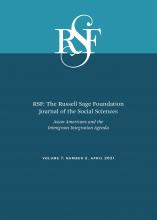Research Article
Open Access
What’s Behind a Racial Category? Uncovering Heterogeneity Among Asian Americans Through a Data-Driven Typology
Lucas G. Drouhot, Filiz Garip
RSF: The Russell Sage Foundation Journal of the Social Sciences April 2021, 7 (2) 22-45; DOI: https://doi.org/10.7758/RSF.2021.7.2.02
Lucas G. Drouhot
aPostdoctoral research fellow at the Max Planck Institute for the Study of Religious and Ethnic Diversity, Germany
Filiz Garip
bProfessor of sociology at Princeton University, United States

REFERENCES
- ↵
- ↵
- Alba, Richard, and
- Victor Nee
- ↵
- Ancheta, Angelo N
- ↵
- Bakk, Zsuzsa,
- Fetene B .Tekle,
- Jeroen K. Vermunt
- ↵
- ↵
- Blau, Peter M
- ↵
- Bonacich, Edna, and
- John Modell
- ↵
- ↵
- Branscombe, Nyla R.,
- Michael T. Schmitt, and
- Richard D. Harvey
- ↵
- Brubaker, Rogers
- ↵
- ↵
- Chou, Rosalind S., and
- Joe R. Feagin
- ↵
- Clark, Shaunna L., and
- Bengt Muthén
- ↵
- Dhingra, Pawan
- ↵
- Donato, Katherine,
- Donna Gabaccia,
- Jennifer Holdaway,
- Martin Manalasan IV., and
- Patricia Pessar
- Drouhot, Lucas G
- ↵
- Drouhot, Lucas G., and
- Victor Nee
- ↵
- FitzGerald, David Scott
- ↵
- ↵
- Garip, Filiz
- ↵
- Gee, Gilbert C.,
- Annie Ro,
- Salma Shariff-Marco, and
- David Chae
- ↵
- Golash-Bosa, Tanya
- ↵
- Gordon, Linda W
- ↵
- Gordon, Milton
- ↵
- Hirschmann, Daniel
- ↵
- Hsin, Amy, and
- Yu Xie
- ↵
- ↵
- Kao, Grace, and
- Jennifer S. Thompson
- ↵
- Kasinitz, Philip,
- Mary Waters,
- John H. Mollenkopf, and
- Jennifer Holdaway
- ↵
- Kibria, Mazli
- ↵
- Kim, ChangHwan, and
- Arthur Sakamoto
- ↵
- Kim, Claire J
- ↵
- Kim, Nadia Y
- ↵
- Kim, Sunmin
- ↵
- ↵
- Krogstad, Jens Manuel, and
- Jynnah Radford
- ↵
- Le Espiritu, Yen
- ↵
- ↵
- Lee, Jennifer, and
- Min Zhou
- ↵
- Lee, Stacey J
- ↵
- Li, Wei
- ↵
- Lien, Pei-te
- ↵
- Lin, Monica H.,
- Virginia S.Y. Kwan,
- Anna Cheung, and
- Susan T. Fiske
- ↵
- Magidson, Jay, and
- Jeroen K. Vermunt
- ↵
- Masuoka, Nathalie
- ↵
- Matsumoto, Noriko
- ↵
- ↵
- Min, Pyong Gap
- ↵
- ↵
- Molina, Mario, and
- Filiz Garip
- ↵
- ↵
- Nee, Victor, and
- Hilary J. Holbrow
- ↵
- Ngo, Bic, and
- Stacey J. Lee
- ↵
- Okamoto, Dina G
- ↵
- ↵
- ↵
- Pew Research Center
- ↵
- Portes, Alejandro, and
- Min Zhou
- ↵
- Qian, Zenchao, and
- Daniel T. Lichter
- ↵
- Qian, Zhenchao,
- Sampson Lee Blair, and
- Stacey D. Ruf
- ↵
- Ramakrishnan, Karthick, and
- Thomas J. Espenshade
- ↵
- Ramakrishnan, Karthick,
- Jennifer Lee,
- Taeku Lee, and
- Janelle Wong
- ↵
- Roy, Dharmendra K., and
- Lokesh K. Sharma
- ↵
- ↵
- Small, Mario Luis,
- David J. Harding, and
- Michèle Lamont
- ↵
- Srinivasan, Shobha, and
- Tessie Guillermo
- ↵
- Sue, Christina A.,
- Fernando Riosmena, and
- Joshua Lepree
- ↵
- Sue, Derald Wing,
- Jennifer Bucceri,
- Annie I. Lin,
- Kevin L. Nadal, and
- Gina C. Torino
- ↵
- Takaki, Ronald
- ↵
- ↵
- Vickerman, Milton
- ↵
- ↵
- Vertovec, Steven
- ↵
- Waters, Mary C., and
- Karl Eschbach
- ↵
- Waters, Mary C., and
- Tomás R. Jiménez
- ↵
- Wimmer, Andreas
- ↵
- Wimmer, Andreas
- ↵
- Wimmer, Andreas, and
- Nina Glick-Schiller
- ↵
- Zhou, Min, and
- Roberto Gonzales
- ↵
- Zhou, Min, and
- Yang Sao Xiong
In this issue
What’s Behind a Racial Category? Uncovering Heterogeneity Among Asian Americans Through a Data-Driven Typology
Lucas G. Drouhot, Filiz Garip
RSF: The Russell Sage Foundation Journal of the Social Sciences Apr 2021, 7 (2) 22-45; DOI: 10.7758/RSF.2021.7.2.02
Jump to section
- Article
- Abstract
- HETEROGENEITY AS A THEORETICAL AND PRACTICAL ISSUE IN MIGRATION RESEARCH
- TENSIONS ACROSS RESEARCH COMMUNITIES
- MOTIVATION OF THIS STUDY
- EMPIRICAL APPROACH AND DATA
- RESULTS
- DISCUSSION: ASIAN AMERICANS—A DIVERSE GROUP BETWEEN ASSIMILATION AND RACIALIZATION
- APPENDIX: TECHNICAL ASPECTS OF LATENT CLASS ANALYSIS WITH STOCHASTIC ASSIGNMENT
- FOOTNOTES
- REFERENCES
- Figures & Data
- Info & Metrics
- References
Related Articles
- No related articles found.
Cited By...
- No citing articles found.





